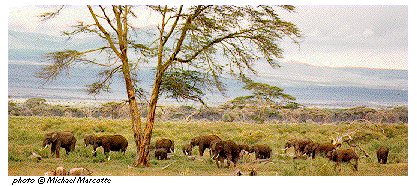 |
|
|
| , | ||||
|
KENYA SAFARI by Michael Marcotte
"What is man without the beasts? If all the beasts were gone, man would die from a great loneliness of the spirit, For whatever happens to the beasts, soon happens to man." - Chief Seattle, 1854
Tail erect, a warthog scampered out of the way of the Landrover's wheels. A bit further along, a Cape buffalo stared at us, unimpressed by our position in the food chain, and then with a 'Go ahead, make my day' expression, tossed its head and sharp horns in defiance. 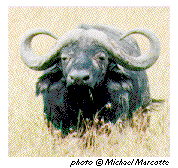
I stood up through the open top of the Landrover, gripping the cross bar for support as the vehicle bumped its way across the savanna, and reveling in the soft caress of the cool, morning breeze on my face. The fresh, clean scent of the tall yellow grass rose from a panorama straight from Out of Africa. In fact, this was part of the backdrop used in the movie. From just in front of our camp, we were able to gaze across at the escarpment used in the movie's famous burial scene. This was the Masai Mara, a seven hundred square mile portion of the Serengeti, situated along the southern border of Kenya with Tanzania. We had just spent two exhilarating weeks in the game reserves of Kenya. Safari is a Swahili word meaning journey. Of all the journeys I have taken, this was the one for which I held the greatest expectations. I had been to the continent of Africa twice before, but only to Morocco and Egypt. North African countries are in a whole different class. This trip was intended to reveal the Africa of childhood fantasies. Tarzan's Africa. 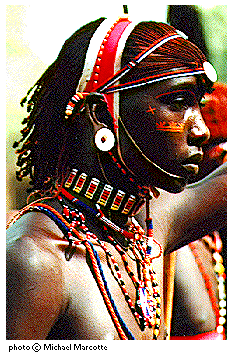
I could never understand the puzzlement of people who asked my wife and me why we would want to travel to Kenya. Who wouldn't want to go there? To me, the very word 'Africa' has always been synonymous with 'Adventure'. I have to admit that the drive from the airport into Nairobi and onward to the hotel altered my expectations for the remainder of the safari. Almost every picture I had seen of Nairobi's skyline featured a giraffe or cheetah on a grassy plain, obviously just a few miles from the city. Such reality indeed exists, but only if you happen to be standing inside Nairobi National Park. The only animals we saw en route to the hotel were two dead monkeys on the road and a small herd of goats. Large wildlife now is to be found only within the game reserves. My mental images of an occasional antelope or zebra spotting the landscape exists, sadly, only in the past. 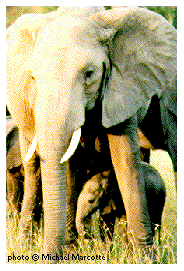
On the positive side, most of Kenya's game reserves are as large in area as counties, or in the case of Tsavo National Reserve (8000 square miles), nearly as large as the state of Massachusetts. The animals in these reserves still live a daily life-and-death existence, and the numerous skeletal remains of zebra, wildebeest and occasional elephant bones quickly reminded us exactly where we were. This is not the drive-through San Diego Wildlife Park. The smallest of the game reserves we visited, called Samburu, was 187 square miles of territory. The Masai Mara occupies just the northern most tip of the vast Serengeti National Park extending deep into neighboring Tanzania. Of the others we visited, Aberdares National Reserve is 230 square miles, and Amboseli is about 200 square miles. In all, there are 48 national parks and reserves in Kenya. Our first safari destination upon leaving Nairobi was "The Ark." This elevated lodge is nestled in the middle of the Aberdares mountains and forests, and like the similarly famous and nearby Treetops Lodge, is built immediately adjacent to a natural salt lick. The animals come here for the minerals in the mud and because the lodge has been there for several years, don't appear particularly to notice the structure or its inhabitants. Unless, that is, there is a sudden movement or loud noise from the large balcony, which sometimes sends even the elephants scurrying. Ever seen an elephant scurry? Guests at the Ark may even turn on a switch for a night buzzer that is rung whenever something deemed interesting approaches the salt lick. Most of the speaking that is done at the Ark is just above a whisper. Guests are requested to keep their voices very low, move slowly when on the viewing balcony, and to wear neutral colors throughout the safari. Bright colors and even solid white can sometimes startle an animal and send it rushing for cover. In the course of the afternoon, we saw only one lion, but a variety of other wildlife, including a herd of 21 elephants, which remained at the lick until past 10 p.m., when most of us retired to our rooms. 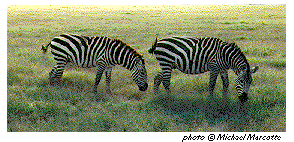
The first night buzzer wasn't until just after 1 a.m., and turned out to be a premature warning. A rhinoceros had been spotted approaching the lick, but between the sounding of the buzzer and the sudden stampede of 40 lodge guests onto the balcony, the rhino had predictably sought anonymity. The next buzzer sounded around 2:15 a.m. and heralded a large herd of Cape buffalo. A steadily decreasing number of tourists found their way to the balcony at each of the subsequent notifications. As for myself, I didn't sleep a minute more the entire night, but instead wandered between the balcony and the other four vantage points of the Ark. At 3 a.m. in the morning, I returned to the balcony for a quick check of anything new. Here I learned NEVER to be anywhere on safari without a camera. Leaning across the right side of the balcony, where I had seen nothing all evening, I could scarcely believe my eyes upon staring into the equally startled face of a large male leopard. This gorgeous creature was sitting fully illuminated beneath the lodge's floodlights in an open grassy area less than forty feet away. I confess that for one brief instant the question crossed my mind whether, should it so choose, the leopard might reach and scale the balcony with greater speed than I might retreat to the door. I quietly but quickly returned to my room, snatched up my camera and sprinted back outside, waking my wife with the urgent advertisement: "Leopard!" By the time I made back to the balcony rail, the leopard had moved, stalking a small bushbuck in some nearby bushes. I had time to snap only two blurry photos, before the jungle cat disappeared into darkness. The watchman, meanwhile alerted to the leopard's presence by my frantic retreat and reappearance, had sounded the buzzer, but only the fleet-footed caught any glimpse of the leopard. The buzzer sounded later for one lone rhinoceros in the company of a giant forest hog, and then again just before dawn for a group of three black rhinoceros. During the rest of the safari we saw no more rhinos, and only a brief glimpse of another leopard. 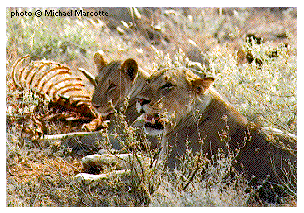
Shortly after breakfast, the resident naturalist, called "the Hunter," guided us back along the elevated walkway to the road and our waiting vehicles, where we continued onward to Samburu country. Until now, we had been in Nairobi and the Aberdares, in Kikuyuland. The Kikuyu tribe is the largest of the native Kenyan tribes, and is the tribe that Karen Blixen befriends in the movie Out of Africa. We had heard reports that the Kikuyu very recently had conducted large scale massacres (please read footnote) of entire villages of smaller tribes in the Rift Valley. Africa is only a very recently "settled" continent (see footnote).* As recently as 1892, British expeditions to explore the interior of Kenya were being attacked and repelled by spear-toting Masai warriors. As in many parts of the world, different tribes here have warred against one another for centuries, and even when a different region of the world deems our Western notions of civilization desirable, such changes neither occur overnight, nor as we know automatically end inter-ethnic violence. The road to Samburu was paved for about 250 fifty miles outside Nairobi. Nairobi lies south of the equator, and we crossed north of the line en route to Samburu. Just before the paved road ended, we entered the town of Isiolo. I had read that this is a good place to find local crafts, and the town is referred to as the "Pearl of the North." Although brimming with local color and "character," Isiolo was the only spot we visited where I felt that things could have gotten ugly, fast. Our guide strongly cautioned us against taking photos in and around Isiolo, warning that in response one of the natives in all probability would launch a spear at the vehicle. The road from Isiolo to the Samburu reserve was a dirt road in poor condition. Every now and then as we neared the reserve we would pass a Samburu tribesman carrying a spear or club. The Samburu, like the Masai, are one of the last tribes who still wear native garb, usually a red colored cloak gathered over one shoulder. Most wore intricate beaded necklaces and armbands. 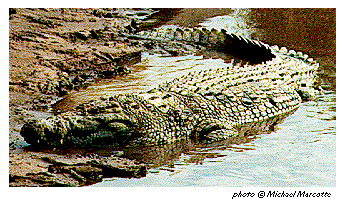
Although the distances we had to travel on these dirt roads was usually 50 to 90 miles, it was frequently slow going, due to the roughness of the road and holes, ruts, or rocks. We arrived at Samburu Serena Lodge just before lunch. The accommodations here consisted of cabins, replete with mosquito netting over the beds. We used the netting more for mood setting, than out of necessity. We were never bothered by insects during our entire trip. Vervet monkeys abound in great numbers at Samburu, and many congregate around the lodges, boldly stealing food from the guests' plates or any other item such as hats or purses left unattended. For this purpose, a Samburu native is employed as the "monkey bouncer." Armed with a club and a slingshot, the monkey bouncer's sole job is to ensure that the monkeys do not become too great a pest. Our personal experience was that this battle had not yet been won by either side and that neither had more of a decisive chance of prevailing than the other. Samburu, like most of the reserves, does not allow off-road driving for game viewing. This is a bit droll, were it not so lamentable, because there are so many roads criss-crossing each other in Samburu that it is difficult to tell where there is not one. Because the park is small, very well known and the only place to see the reticulated giraffe and Grevy's zebra, it is apparently always crowded. At one point, while watching a solitary male lion, there were six-to-eight vehicles forming a circle around the lion. Had this been the trend versus the exception, the safari would have seemed a farce. 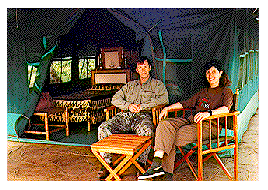
Later that day we came upon a small pride of lions finishing the remains of an oryx or sable antelope. It was difficult to say, since only a very small piece of hide, the bare rib cage and the partially obscured horns were left. As we approached, a couple of the lions began to stalk a nearby herd of zebra. The zebra were quite aware of the lions' presence and promptly galloped off to a safer distance. Lions do almost all of their hunting at night, and we never witnessed a kill. Our guide, Ronnie, told us the animals sense this, and it isn't uncommon to see antelope or zebra in the same general vicinity of lions. Nonetheless, he added, if another animal were to get too close, a lion would kill it whether it was hungry or not. In Ronnie's words, "Lions don't like a cheeky zebra." The harsh landscape of the Samburu reserve is dotted with huge termite mounds of hardened red clay and the desert rose, a shrub densely covered with beautiful red blossoms. We saw several species of wildlife during our three game drives there, including giraffe, zebra, lions, baboons, monkeys, Grant's gazelles, impala and ostrich. At the end of our second day's game drive at Samburu, the guards at the entrance from our camp told our driver that a leopard had just appeared less than five minutes earlier, headed toward the river. We searched in vain for about 10 more minutes before heading into camp. About an hour later, as we sat in the lodge's covered bar, we got a very brief and distant view of the leopard across the river, as it approached to sniff, then ignore a piece of bait hung there for that purpose. The next destination on our safari was Mount Kenya, back again to the south and on the equator. The area surrounding Mount Kenya seemed the most fertile of the country, as evidenced by huge farms growing wheat, coffee, tea, and corn. Only about 20 percent of the land in Kenya is considered fit for farming, so most of the population is found in dense concentrations, almost entirely within the 200-mile area around Nairobi. The countryside varies dramatically depending upon where you are. The Aberdares is lush, green rain forest with red soil and rolling hills. The Samburu countryside and the area around Amboseli is made up of sparse vegetation amid rocky fields. The Masai Mara, along Kenya's border with Tanzania, is beautiful grasslands with a few acacia trees here and there, dense concentrations of taller jungle-looking trees lining the twisting Mara river, all set below scenic escarpments. Africa's two highest mountains are both visible from within Kenya. Mount Kilimanjaro is just 30 miles inside Tanzania, and rises 19,000 feet.. Mount Kenya is the second highest and postcard-scenic. 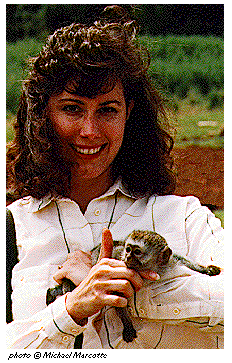
Our lodging at Mount Kenya was the world-renowned Mount Kenya Safari Club. Founded in 1956, by the actor William Holden, our stay here was a "back to civilization" break. Set at the base of Mount Kenya, the surrounding view is spectacular. Sculpted grounds, greenery and flowery shrubs frame the majestic peak rising 17,000 feet. Surrounding the club is a 1,000-acre reserve, aggressively used by the government to educate the country's young on the value of the Kenya's wildlife. Also immediately adjacent to the club is the Mount Kenya Animal Orphanage, where young ostriches follow you around as you visit a little with a baby Vervet, bushbaby, giant tortoise, or a young chimpanzee. The intent, we were told, is to release the animals back into the wild whenever possible. My personal favorites were two baby zebras. The Mount Kenya Safari Club is located on the equator, and after the requisite photos next to a sign stating this fact, we continued south the next morning for our longest drive of the safari, 300 miles along paved tarmac through Nairobi and southward to the Tanzanian border. Here we drove through a quintessential frontier town and onto the most bone-rattling 68-mile dirt-and-rock road in either hemisphere, leading up to one of the two entrances to the Amboseli National Reserve. Amboseli Reserve lies 30 miles from the base of Mount Kilimanjaro. Many of the postcards printed in Kenya feature a scene with an elephant or giraffe in the foreground and this massive mountain in the background. Unfortunately, the summit is frequently obscured by clouds and no such photography was possible during our two days in Amboseli. Each reserve is unique, and while we saw absolutely no lions or cheetah or leopards here, the elephants were both larger and more numerous here than at Aberdares or Samburu. 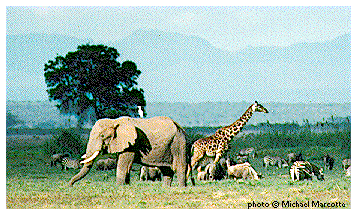
We also saw our first wildebeest here, and in parts of the reserve we frequently would encounter vast numbers of these intermixed with zebra, giraffe, elephant and various antelope. This was very similar, we were told by our guide, to how he remembered the majority of Kenya in his younger years. I have, quite simply, never seen anything like it. It was incredible. The Vervet monkeys were bolder here than anywhere. We chased one from inside our hut one morning and another from inside our van during a game drive. One of our group in the other vehicle tried to pet one of these pesky monkeys, when it pounced upon their van, and she received a nasty bite between her thumb and forefinger. The Masai still must water their cattle inside the Amboseli reserve, due to the lack of water in the surrounding area. Ronnie speculated that the lions recently had been pretty much poisoned off by the Masai to protect their cattle herds. He also said he hadn't seen a cheetah in Amboseli in three years. On one side of the reserve a small, very shallow soda lake had formed recently, and one bank was always covered by hundreds of thousands of pink flamingos. A flock of perhaps a thousand or more took wing one afternoon as we were watching, imaginably impressive, as they flew closely past our vehicle. Our accommodations here, the Amboseli Serena Lodge, were patterned to resemble Masai or Samburu huts. They were, of course, much more comfortable. Like all of the lodges and tented camps where we stayed, I thought this one was quite pleasingly unobtrusive, both to the animals and to the safari-goers. The bumpy ride back out of Amboseli didn't seem quite as bad as the journey in. Our next stop was Nairobi, only a half day's drive. We lunched at the Carnivore Restaurant just outside Nairobi, where tourists and locals are offered all they can eat of crocodile, hartebeest, zebra or other exotic fare. Beef and chicken are available for the more timid adventurers. 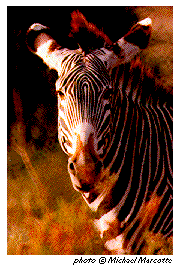
After lunch, we boarded a small twin-engine plane at Nairobi's Wilson Airport and flew to the final reserve on our itinerary - the Masai Mara. The one-hour flight crossing the impressive Rift Valley passed quickly. Soon we landed at the airstrip just down from our tented camp, Kichwa Tembo. At first, I was a little amused to note that the landing site consisted solely of a leveled dirt strip. In retrospect, I wouldn't have it any other way. The less we alteration, the better. Landrovers drive down the strip just prior to planes landing, to chase away lions that might be sunning in the middle of the strip, or to shoo away water buffalo that have gotten too close. Kichwa Tembo means Elephant Head in Swahili, and true to its name, an elephant skull rests next to the entrance to the camp. This is what the itineraries call a "luxury" tented camp. We enjoyed the experience of spending the nights in tents, listening to the night sounds of a herd of nearby Cape buffalo, the trumpeting of an elephant and the screech of a bushbaby in the trees above our tent, but by the same token, we were not disappointed to have both an indoor shower and toilet, discreetly behind a flap at the back of the tent! Our own tent was located at the most distant end of a foot path leading through the edge of the woods. A sign posted just a few feet away warned: Do Not Proceed Beyond This Point - Wild Animals! One of our safari companions had asked Shieni, our driver, if there were any snakes around here. He spooked us a bit by informing us that both the deadly black mamba and the spitting cobra were native to the Mara. 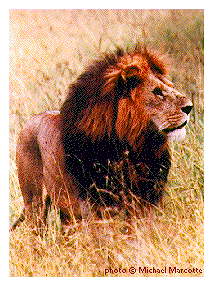
The Mara quickly became our favorite stop on the safari, with its abundance of wildlife, particularly lions, elephants, zebras and hippopotamuses, the tall golden grassy plains and the bordering escarpments. More so than anywhere during the trip, we were enjoying acutely the realization that we were on a real Safari. The morning following our arrival in the Mara, we took a hot air balloon trip and floated across the treetops, river and savannah for an hour. We crossed the winding Mara river several times during the flight and saw quite a few hippopotamuses from above. The few elephants that we flew over seemed to react with various levels of agitation, depending upon how closely we passed. Some just lifted their trunks and sniffed the air; another trumpeted and ran away. The fairly frequent roar of the flames disturbs some of the animals directly below the path of the balloon, since we were often flying relatively low over the ground. I had never before been in a hot air balloon, and I always had assumed that after a flight the balloon sets back down neatly in an upright position. In actuality, the basket drags along the ground, then tips over on its side and after a few moments slides to a halt. Our pilot showed us the proper landing position (somewhat like the crash landing position for airliners) and warned us the ride could get a little rough if we were to hit a termite mound. We weren't dragged far. Landing in an open area beyond the actual reserve and just a few miles north of the Tanzanian border, we were quickly met by the support vehicles and treated to a champagne breakfast out in the middle of the tall grassy savannah. Although we really would not expect any of the few animals that might be around to approach our group, a pair of the Masai stood watch with rifles, just in case. During the game drives through the Mara, we saw lions, elephant, giraffe, cheetah, hyena, gazelle, impala and herds of hundreds, perhaps thousands, of zebra. The annual migration had not yet reached the Masai Mara, so the grass was still high. I can only imagine the image the Mara presents when these plains are blanketed with the nearly two million wildebeest and thousands of zebra and other migrating animals. As it was, we became so accustomed to seeing zebra and wildebeest that, for several days after our return home, I would have to do a double-take when I caught a peripheral glimpse of a horse or cow along a rural road. On the banks of the Mara river we occasionally dismounted from our Landrover to snap photos of groups of hippos and huge crocodiles. During the annual migration, wildebeest jumping into the river break their legs by the hundreds and are vigorously fed upon by the crocodiles. We didn't see anything get eaten, although we watched in great anticipation as a crane walked up about three feet from one monstrously large crocodile. "This bird is in grave danger..." one of the Masai drivers told us solemnly. 
By no stretch of the imagination are the safaris offered today anything like those in the earlier half of this century, when adventurers braved a lot more than bandits and malaria, and crossed the savannah on foot. But there is still enough of a thrill and inherent risk at the surprisingly close proximity of the Landrovers to the elephants and lions to stir the blood of most tourists, at least at little. (Most of us enjoy a little blood stirring; it's the blood letting we can do without). We were very lucky to see all of the "Big Five" - Elephant, Lion, Leopard, Rhino and Cape Buffalo. Cheetah were also harder to find than I would have thought. Most of the still-dwindling wildlife has been reduced due to loss of habitat as Kenya's population, one of the fastest increasing in the world, spreads across the country seeking land for farming and grazing of livestock. The elephant population of Kenya also has been drastically reduced by poachers. There are many places we did not get to see on this short safari, including the largest of Kenya's reserves, Tsavo, and Meru, or the Rift Valley reserves, Lake Victoria, or the coastal cities of Mombasa or Malindi. All that can really be hoped for, in any such journey, is a just a taste of the rich variety of Kenya's people, wildlife and countryside. John Donne wrote, "...every man's death diminishes me." Likewise, as expressed by Chief Seattle, it seems innately true that the extinction of any animal species diminishes our own species. Anyone who ever has seen the Masai Mara must feel a deep loss, as did I, at the realization of what has vanished irretrievably from the African jungles and savannahs. Despite such change, Kenya managed to be everything I had hoped it would be. I just wish there was more assurance it will remain that way. - Michael Marcotte Addendum:
Click here for More Photos from this Safari  RETURN TO HOME PAGE Back to Michael's Magazine Articles Page |
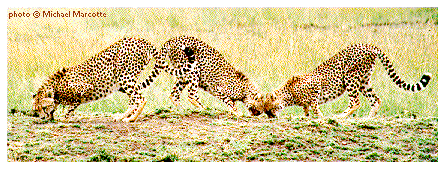
 uring the drive from the Kichwa Tembo tented camp to the nearby air strip, the mood was subdued. No one had uttered more than a few words since boarding the Landrover, and each of us, thinking about our imminent trip out of Africa, wore inwardly reflective or forlorn expressions. This was the final time that we would cross these vast, grassy plains of the Masai Mara; the last cool early morning drive past herds of buffalo, elephant , wildebeest and zebra.
uring the drive from the Kichwa Tembo tented camp to the nearby air strip, the mood was subdued. No one had uttered more than a few words since boarding the Landrover, and each of us, thinking about our imminent trip out of Africa, wore inwardly reflective or forlorn expressions. This was the final time that we would cross these vast, grassy plains of the Masai Mara; the last cool early morning drive past herds of buffalo, elephant , wildebeest and zebra.